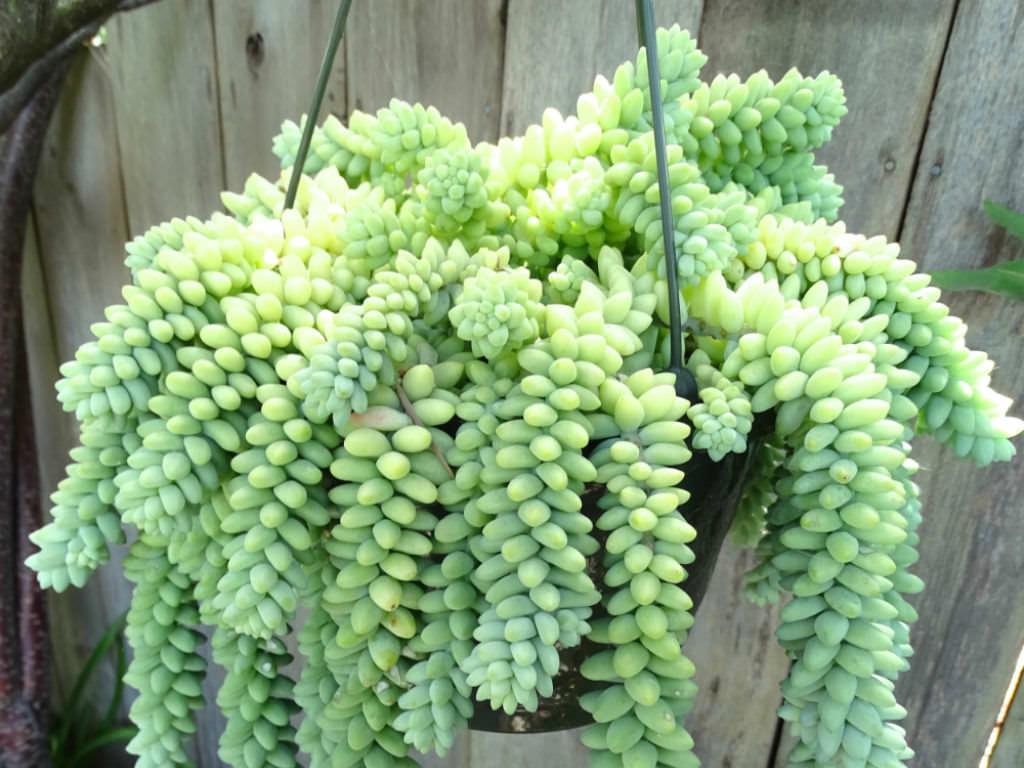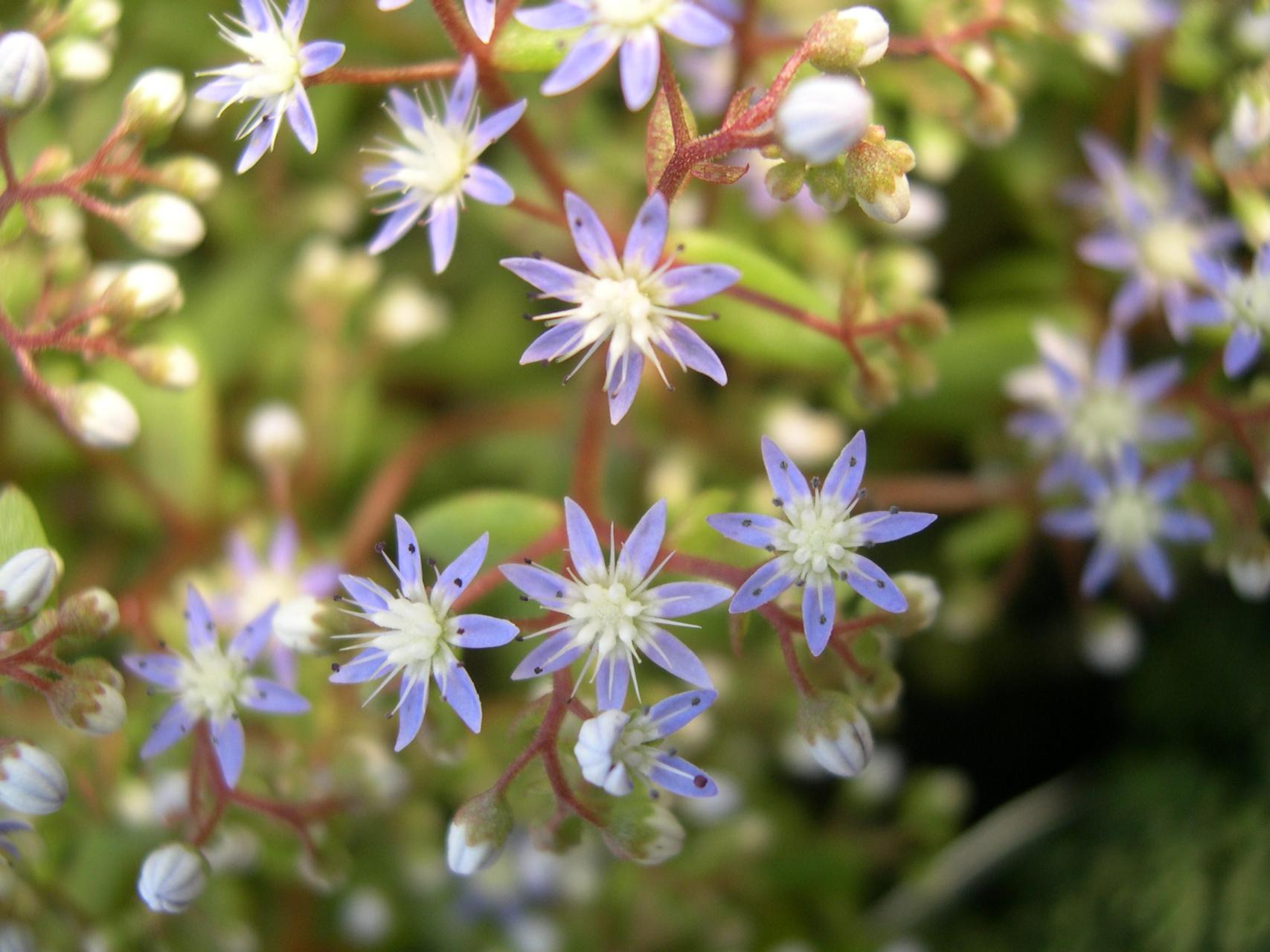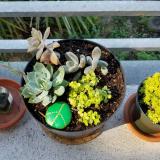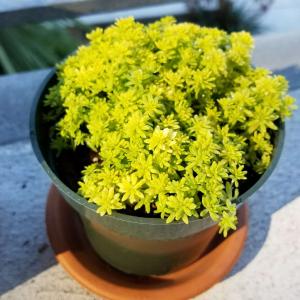文章
Dummer. ゛☀
2017年10月01日

Scientific Name
Sedum multiceps Coss. & Durieu
Common Names
Miniature Joshua Tree, Little Joshua Tree, Baby Joshua Tree
Scientific Classification
Family: Crassulaceae
Subfamily: Sedoideae
Tribe: Sedeae
Subtribe: Sedinae
Genus: Sedum
Description
Sedum multiceps forms a miniature, much-branched sub-shrub, up to 6 inches (15 cm) tall. Most of the tiny glaucous grayish-green leaves are in clusters near the tips of the branches, giving the appearance of miniature “Joshua Trees”. Flowers are star-shaped, yellow in color. Blooms during summer months.
How to Grow and Care
When growing Sedum, keep in mind that Sedum plants need very little attention or care. They will thrive in conditions that many other plants thrive in, but will do just as well in less hospitable areas. They are ideal for that part of your yard that gets too much sun or too little water to grow anything else. A common name for Sedum is Stonecrop, due to the fact that many gardeners joke that only stones need less care and live longer.
Sedum is easily planted. For shorter varieties, simply laying the plant on the ground where you want it to grow is normally enough to get the Sedum plant started there. They will send out roots from wherever the stem is touching the ground and root itself. If you would like to further ensure that the plant will start there, you can add a very thin covering of soil over the plant.
For taller Sedum varieties, you can break off one of the stems and push it into the ground where you would like to grow it.
Sedum multiceps Coss. & Durieu

Common Names
Miniature Joshua Tree, Little Joshua Tree, Baby Joshua Tree
Scientific Classification
Family: Crassulaceae
Subfamily: Sedoideae
Tribe: Sedeae
Subtribe: Sedinae
Genus: Sedum

Description
Sedum multiceps forms a miniature, much-branched sub-shrub, up to 6 inches (15 cm) tall. Most of the tiny glaucous grayish-green leaves are in clusters near the tips of the branches, giving the appearance of miniature “Joshua Trees”. Flowers are star-shaped, yellow in color. Blooms during summer months.

How to Grow and Care
When growing Sedum, keep in mind that Sedum plants need very little attention or care. They will thrive in conditions that many other plants thrive in, but will do just as well in less hospitable areas. They are ideal for that part of your yard that gets too much sun or too little water to grow anything else. A common name for Sedum is Stonecrop, due to the fact that many gardeners joke that only stones need less care and live longer.

Sedum is easily planted. For shorter varieties, simply laying the plant on the ground where you want it to grow is normally enough to get the Sedum plant started there. They will send out roots from wherever the stem is touching the ground and root itself. If you would like to further ensure that the plant will start there, you can add a very thin covering of soil over the plant.
For taller Sedum varieties, you can break off one of the stems and push it into the ground where you would like to grow it.
0
1
文章
Dummer. ゛☀
2017年10月01日

Scientific Name
Sedum burrito Moran
Common Names
Burro’s Tail, Donkey’s Tail, Baby Donkey Tail
Synonyms
Sedum morganianum ‘Burrito’
Scientific Classification
Family: Crassulaceae
Subfamily: Sedoideae
Tribe: Sedeae
Subtribe: Sedinae
Genus: Sedum
Description
Sedum burrito is a perennial, evergreen, pendent succulent with many long hanging stems up to 3.3 feet (1 m) long and fleshy blue-green leaves. It is related to Sedum morganianum, but has smaller and more compact, spherical and shorter leaves.
How to Grow and Care
When growing Sedum, keep in mind that Sedum plants need very little attention or care. They will thrive in conditions that many other plants thrive in, but will do just as well in less hospitable areas. They are ideal for that part of your yard that gets too much sun or too little water to grow anything else. A common name for Sedum is Stonecrop, due to the fact that many gardeners joke that only stones need less care and live longer.
Sedum is easily planted. For shorter varieties, simply laying the Sedum on the ground where you want it to grow is normally enough to get the Sedum plant started there. They will send out roots from wherever the stem is touching the ground and root itself. If you would like to further ensure that the plant will start there, you can add a very thin covering of soil over the plant. For taller Sedum varieties, you can break off one of the stems and push it into the ground where you would like to grow it.
Sedum burrito Moran
Common Names
Burro’s Tail, Donkey’s Tail, Baby Donkey Tail

Synonyms
Sedum morganianum ‘Burrito’
Scientific Classification
Family: Crassulaceae
Subfamily: Sedoideae
Tribe: Sedeae
Subtribe: Sedinae
Genus: Sedum

Description
Sedum burrito is a perennial, evergreen, pendent succulent with many long hanging stems up to 3.3 feet (1 m) long and fleshy blue-green leaves. It is related to Sedum morganianum, but has smaller and more compact, spherical and shorter leaves.

How to Grow and Care
When growing Sedum, keep in mind that Sedum plants need very little attention or care. They will thrive in conditions that many other plants thrive in, but will do just as well in less hospitable areas. They are ideal for that part of your yard that gets too much sun or too little water to grow anything else. A common name for Sedum is Stonecrop, due to the fact that many gardeners joke that only stones need less care and live longer.

Sedum is easily planted. For shorter varieties, simply laying the Sedum on the ground where you want it to grow is normally enough to get the Sedum plant started there. They will send out roots from wherever the stem is touching the ground and root itself. If you would like to further ensure that the plant will start there, you can add a very thin covering of soil over the plant. For taller Sedum varieties, you can break off one of the stems and push it into the ground where you would like to grow it.
3
3
文章
Dummer. ゛☀
2017年10月01日

Scientific Name
Sedum caeruleum L.
Common Names
Azure Stonecrop, Blue Stonecrop, Sky Stone Crop, Baby-blue Stone Crop, Red Leaf, Barbary Stones
Synonyms
Anacampseros caerulescens, Oreosedum caeruleum, Sedum azureum, Sedum coeruleum, Sedum heptapetalum
Scientific Classification
Family: Crassulaceae
Subfamily: Sedoideae
Tribe: Sedeae
Subtribe: Sedinae
Genus: Sedum
Description
Sedum caeruleum is an annual, succulent, bushy herb, simple or much branched from the base, erect, up to 6 inches (15 cm) tall. The leaves are green, narrowly oblong and usually tinted red, up to 1 inch (2.5 cm) long. It produces cymes of pale blue or white (rarely pinkish), many-stellate flowers from July to September.
How to Grow and Care
When growing Sedum, keep in mind that Sedum plants need very little attention or care. They will thrive in conditions that many other plants thrive in, but will do just as well in less hospitable areas. They are ideal for that part of your yard that gets too much sun or too little water to grow anything else. A common name for Sedum is Stonecrop, due to the fact that many gardeners joke that only stones need less care and live longer.
Sedum is easily planted. For shorter varieties, simply laying the plant on the ground where you want it to grow is normally enough to get the Sedum plant started there. They will send out roots from wherever the stem is touching the ground and root itself. If you would like to further ensure that the plant will start there, you can add a very thin covering of soil over the plant. For taller Sedum varieties, you can break off one of the stems and push it into the ground where you would like to grow it.
Sedum caeruleum L.

Common Names
Azure Stonecrop, Blue Stonecrop, Sky Stone Crop, Baby-blue Stone Crop, Red Leaf, Barbary Stones
Synonyms
Anacampseros caerulescens, Oreosedum caeruleum, Sedum azureum, Sedum coeruleum, Sedum heptapetalum
Scientific Classification
Family: Crassulaceae
Subfamily: Sedoideae
Tribe: Sedeae
Subtribe: Sedinae
Genus: Sedum

Description
Sedum caeruleum is an annual, succulent, bushy herb, simple or much branched from the base, erect, up to 6 inches (15 cm) tall. The leaves are green, narrowly oblong and usually tinted red, up to 1 inch (2.5 cm) long. It produces cymes of pale blue or white (rarely pinkish), many-stellate flowers from July to September.

How to Grow and Care
When growing Sedum, keep in mind that Sedum plants need very little attention or care. They will thrive in conditions that many other plants thrive in, but will do just as well in less hospitable areas. They are ideal for that part of your yard that gets too much sun or too little water to grow anything else. A common name for Sedum is Stonecrop, due to the fact that many gardeners joke that only stones need less care and live longer.

Sedum is easily planted. For shorter varieties, simply laying the plant on the ground where you want it to grow is normally enough to get the Sedum plant started there. They will send out roots from wherever the stem is touching the ground and root itself. If you would like to further ensure that the plant will start there, you can add a very thin covering of soil over the plant. For taller Sedum varieties, you can break off one of the stems and push it into the ground where you would like to grow it.
0
2
文章
Dummer. ゛☀
2017年10月01日

Scientific Name
Hylotelephium telephium ‘Matrona’
Common Names
Autumn Stonecrop
Synonyms
Sedum telephium ‘Matrona’, Sedum ‘Matrona’
Scientific Classification
Family: Crassulaceae
Subfamily: Sedoideae
Tribe: Sedeae
Subtribe: Sedinae
Genus: Hylotelephium
Description
Hylotelephium telephium ‘Matrona’ typically grows in upright, vase-shaped clumps up to 30 inches (75 cm) tall. Masses of tiny, star-like, pastel pink flowers bloom in large flattened heads (cymes up to 6 inches/15 cm across) atop shiny, purplish-red stems clad with fleshy, succulent, bronze-tinged, gray-green leaves. Long mid-summer to early fall bloom. Foliage is effective throughout the growing season.
How to Grow and Care
When growing Sedum, keep in mind that Sedum plants need very little attention or care. They will thrive in conditions that many other plants thrive in, but will do just as well in less hospitable areas. They are ideal for that part of your yard that gets too much sun or too little water to grow anything else. A common name for Sedum is Stonecrop, due to the fact that many gardeners joke that only stones need less care and live longer.
Sedum is easily planted. For shorter varieties, simply laying the plant on the ground where you want it to grow is normally enough to get the Sedum plant started there. They will send out roots from wherever the stem is touching the ground and root itself. If you would like to further ensure that the plant will start there, you can add a very thin covering of soil over the plant.
For taller Sedum varieties, you can break off one of the stems and push it into the ground where you would like to grow it.
Hylotelephium telephium ‘Matrona’

Common Names
Autumn Stonecrop
Synonyms
Sedum telephium ‘Matrona’, Sedum ‘Matrona’
Scientific Classification
Family: Crassulaceae
Subfamily: Sedoideae
Tribe: Sedeae
Subtribe: Sedinae
Genus: Hylotelephium

Description
Hylotelephium telephium ‘Matrona’ typically grows in upright, vase-shaped clumps up to 30 inches (75 cm) tall. Masses of tiny, star-like, pastel pink flowers bloom in large flattened heads (cymes up to 6 inches/15 cm across) atop shiny, purplish-red stems clad with fleshy, succulent, bronze-tinged, gray-green leaves. Long mid-summer to early fall bloom. Foliage is effective throughout the growing season.

How to Grow and Care
When growing Sedum, keep in mind that Sedum plants need very little attention or care. They will thrive in conditions that many other plants thrive in, but will do just as well in less hospitable areas. They are ideal for that part of your yard that gets too much sun or too little water to grow anything else. A common name for Sedum is Stonecrop, due to the fact that many gardeners joke that only stones need less care and live longer.

Sedum is easily planted. For shorter varieties, simply laying the plant on the ground where you want it to grow is normally enough to get the Sedum plant started there. They will send out roots from wherever the stem is touching the ground and root itself. If you would like to further ensure that the plant will start there, you can add a very thin covering of soil over the plant.
For taller Sedum varieties, you can break off one of the stems and push it into the ground where you would like to grow it.
0
1
文章
Dummer. ゛☀
2017年10月01日

Scientific Name
Sedum rupestre ‘Angelina’
Common Names
Angelina Stonecrop, Golden Sedum
Synonyms
Sedum ‘Angelina’
Scientific Classification
Family: Crassulaceae
Subfamily: Sedoideae
Tribe: Sedeae
Subtribe: Sedinae
Genus: Sedum
Description
Sedum rupestre ‘Angelina’ is an evergreen, mat-forming, rapidly growing plant, up to 5 inches (12.5 cm) tall with a prostrate, creeping habit. Its needle-like, succulent foliage is lime green in spring that ages to a brilliant golden-yellow color that is topped off with clusters of vibrant yellow, star-shaped flowers in summer on up to 8 inches long stems. In fall the foliage takes on an orange hue.
How to Grow and Care
When growing Sedum, keep in mind that Sedum plants need very little attention or care. They will thrive in conditions that many other plants thrive in, but will do just as well in less hospitable areas. They are ideal for that part of your yard that gets too much sun or too little water to grow anything else. A common name for Sedum is Stonecrop, due to the fact that many gardeners joke that only stones need less care and live longer.
Sedum is easily planted. For shorter varieties, simply laying the plant on the ground where you want it to grow is normally enough to get the Sedum plant started there. They will send out roots from wherever the stem is touching the ground and root itself. If you would like to further ensure that the plant will start there, you can add a very thin covering of soil over the plant. For taller Sedum varieties, you can break off one of the stems and push it into the ground where you would like to grow it.
Sedum rupestre ‘Angelina’

Common Names
Angelina Stonecrop, Golden Sedum
Synonyms
Sedum ‘Angelina’
Scientific Classification
Family: Crassulaceae
Subfamily: Sedoideae
Tribe: Sedeae
Subtribe: Sedinae
Genus: Sedum

Description
Sedum rupestre ‘Angelina’ is an evergreen, mat-forming, rapidly growing plant, up to 5 inches (12.5 cm) tall with a prostrate, creeping habit. Its needle-like, succulent foliage is lime green in spring that ages to a brilliant golden-yellow color that is topped off with clusters of vibrant yellow, star-shaped flowers in summer on up to 8 inches long stems. In fall the foliage takes on an orange hue.

How to Grow and Care
When growing Sedum, keep in mind that Sedum plants need very little attention or care. They will thrive in conditions that many other plants thrive in, but will do just as well in less hospitable areas. They are ideal for that part of your yard that gets too much sun or too little water to grow anything else. A common name for Sedum is Stonecrop, due to the fact that many gardeners joke that only stones need less care and live longer.

Sedum is easily planted. For shorter varieties, simply laying the plant on the ground where you want it to grow is normally enough to get the Sedum plant started there. They will send out roots from wherever the stem is touching the ground and root itself. If you would like to further ensure that the plant will start there, you can add a very thin covering of soil over the plant. For taller Sedum varieties, you can break off one of the stems and push it into the ground where you would like to grow it.
0
1
文章
Dummer. ゛☀
2017年10月01日

Scientific Name
Phedimus aizoon (L.) ’t Hart
Common Names
Aizoon Stonecrop, Orpin Aizoon, Fei Cai
Synonyms
Sedum aizoon (basionym), Phedimus ellacombianus, Sedum ellacombianum
Scientific Classification
Family: Crassulaceae
Subfamily: Sedoideae
Tribe: Sedeae
Subtribe: Sedinae
Genus: Phedimus
Description
Phedimus aizoon is a perennial succulent plant, up to 16 inches (40 cm) tall with blade elliptic-lanceolate leaves, up to 3 inches (7.5 cm) long and up to 0.8 inch (2 cm) wide. The stems are topped with light yellow flower clusters.
How to Grow and Care
There are few plants more forgiving of sun and bad soil than Sedum plants. Growing Sedum is easy, so easy, in fact, that even the most novice gardener can excel at it. With a large number of Sedum varieties to choose from, you will find one that works for your garden. When growing Sedum, keep in mind that Sedum plants need very little attention or care. They will thrive in conditions that many other plants thrive in, but will do just as well in less hospitable areas. They are ideal for that part of your yard that gets too much sun or too little water to grow anything else. A common name for Sedum is Stonecrop, due to the fact that many gardeners joke that only stones need less care and live longer.
Sedum is easily planted. For shorter varieties, simply laying the Sedum on the ground where you want it to grow is normally enough to get the Sedum plant started there.
Phedimus aizoon (L.) ’t Hart

Common Names
Aizoon Stonecrop, Orpin Aizoon, Fei Cai
Synonyms
Sedum aizoon (basionym), Phedimus ellacombianus, Sedum ellacombianum
Scientific Classification
Family: Crassulaceae
Subfamily: Sedoideae
Tribe: Sedeae
Subtribe: Sedinae
Genus: Phedimus

Description
Phedimus aizoon is a perennial succulent plant, up to 16 inches (40 cm) tall with blade elliptic-lanceolate leaves, up to 3 inches (7.5 cm) long and up to 0.8 inch (2 cm) wide. The stems are topped with light yellow flower clusters.

How to Grow and Care
There are few plants more forgiving of sun and bad soil than Sedum plants. Growing Sedum is easy, so easy, in fact, that even the most novice gardener can excel at it. With a large number of Sedum varieties to choose from, you will find one that works for your garden. When growing Sedum, keep in mind that Sedum plants need very little attention or care. They will thrive in conditions that many other plants thrive in, but will do just as well in less hospitable areas. They are ideal for that part of your yard that gets too much sun or too little water to grow anything else. A common name for Sedum is Stonecrop, due to the fact that many gardeners joke that only stones need less care and live longer.

Sedum is easily planted. For shorter varieties, simply laying the Sedum on the ground where you want it to grow is normally enough to get the Sedum plant started there.
0
1
文章
Dummer. ゛☀
2017年10月01日

Scientific Name
Sedum adolphii Raym.-Hamet
Common Names
Adolph’s Sedum, Golden Sedum
Scientific Classification
Family: Crassulaceae
Subfamily: Sedoideae
Tribe: Sedeae
Subtribe: Sedinae
Genus: Sedum
Description
Sedum adolphii is a lovely high colored tender succulent, up to 8 inches (20 cm) tall. It is a rangy creeper, developing casual rosettes of football shaped yellow green leaves, up to 1.4 inches (3.5 cm) long. Only when grown in the sun do they take on the orange-red highlights that make it a visual delight. As rosettes age they produce new leaves at the center, shedding the oldest that drop off and root where conditions are right. It blooms in spring with small cream colored flower heads produced at the tips.
How to Grow and Care
When growing Sedum, keep in mind that Sedum plants need very little attention or care. They will thrive in conditions that many other plants thrive in, but will do just as well in less hospitable areas. They are ideal for that part of your yard that gets too much sun or too little water to grow anything else. A common name for Sedum is Stonecrop, due to the fact that many gardeners joke that only stones need less care and live longer.
Sedum is easily planted. For shorter varieties, simply laying the plant on the ground where you want it to grow is normally enough to get the Sedum plant started there. They will send out roots from wherever the stem is touching the ground and root itself. If you would like to further ensure that the plant will start there, you can add a very thin covering of soil over the plant. For taller Sedum varieties, you can break off one of the stems and push it into the ground where you would like to grow it.
Origin
Native to the Cape region of South Africa.
Sedum adolphii Raym.-Hamet

Common Names
Adolph’s Sedum, Golden Sedum
Scientific Classification
Family: Crassulaceae
Subfamily: Sedoideae
Tribe: Sedeae
Subtribe: Sedinae
Genus: Sedum

Description
Sedum adolphii is a lovely high colored tender succulent, up to 8 inches (20 cm) tall. It is a rangy creeper, developing casual rosettes of football shaped yellow green leaves, up to 1.4 inches (3.5 cm) long. Only when grown in the sun do they take on the orange-red highlights that make it a visual delight. As rosettes age they produce new leaves at the center, shedding the oldest that drop off and root where conditions are right. It blooms in spring with small cream colored flower heads produced at the tips.

How to Grow and Care
When growing Sedum, keep in mind that Sedum plants need very little attention or care. They will thrive in conditions that many other plants thrive in, but will do just as well in less hospitable areas. They are ideal for that part of your yard that gets too much sun or too little water to grow anything else. A common name for Sedum is Stonecrop, due to the fact that many gardeners joke that only stones need less care and live longer.

Sedum is easily planted. For shorter varieties, simply laying the plant on the ground where you want it to grow is normally enough to get the Sedum plant started there. They will send out roots from wherever the stem is touching the ground and root itself. If you would like to further ensure that the plant will start there, you can add a very thin covering of soil over the plant. For taller Sedum varieties, you can break off one of the stems and push it into the ground where you would like to grow it.

Origin
Native to the Cape region of South Africa.
6
4
文章
Dummer. ゛☀
2017年10月01日

Scientific Name
Rhodiola rosea L.
Common Names
Golden Root, Rose Root, Aaron’s Rod, Arctic Root, King’s Crown, Orpin Rose
Synonyms
Rhodiola roanensis, Sedum rhodiola, Sedum roanense, Sedum rosea
Scientific Classification
Family: Crassulaceae
Genus: Rhodiola
Description
Rhodiola rosea is a succulent herb up to 16 inches (40 cm) tall with several stems growing from a short, scaly rootstock. Flowers have 4 sepals and 4 petals, yellow to greenish-yellow in color sometimes tipped with red and blooming in summer. Several shoots growing from the same thick root may reach up to 14 inches (35 cm) in height. It is dioecious – having separate female and male plants.
How to Grow and Care
When growing Sedum, keep in mind that Sedum plants need very little attention or care. They will thrive in conditions that many other plants thrive in, but will do just as well in less hospitable areas. They are ideal for that part of your yard that gets too much sun or too little water to grow anything else. A common name for Sedum is Stonecrop, due to the fact that many gardeners joke that only stones need less care and live longer.
Sedum is easily planted. For shorter varieties, simply laying the plant on the ground where you want it to grow is normally enough to get the Sedum plant started there. They will send out roots from wherever the stem is touching the ground and root itself. If you would like to further ensure that the plant will start there, you can add a very thin covering of soil over the plant. For taller Sedum varieties, you can break off one of the stems and push it into the ground where you would like to grow it. The stem will root very easily and anew plant will be established in a season or two… – See more at: How to Grow and Care for Sedum.
Origin
It grows naturally in wild Arctic regions of Europe, including Britain, Asia and North America.
Rhodiola rosea L.
Common Names
Golden Root, Rose Root, Aaron’s Rod, Arctic Root, King’s Crown, Orpin Rose

Synonyms
Rhodiola roanensis, Sedum rhodiola, Sedum roanense, Sedum rosea
Scientific Classification
Family: Crassulaceae
Genus: Rhodiola

Description
Rhodiola rosea is a succulent herb up to 16 inches (40 cm) tall with several stems growing from a short, scaly rootstock. Flowers have 4 sepals and 4 petals, yellow to greenish-yellow in color sometimes tipped with red and blooming in summer. Several shoots growing from the same thick root may reach up to 14 inches (35 cm) in height. It is dioecious – having separate female and male plants.

How to Grow and Care
When growing Sedum, keep in mind that Sedum plants need very little attention or care. They will thrive in conditions that many other plants thrive in, but will do just as well in less hospitable areas. They are ideal for that part of your yard that gets too much sun or too little water to grow anything else. A common name for Sedum is Stonecrop, due to the fact that many gardeners joke that only stones need less care and live longer.

Sedum is easily planted. For shorter varieties, simply laying the plant on the ground where you want it to grow is normally enough to get the Sedum plant started there. They will send out roots from wherever the stem is touching the ground and root itself. If you would like to further ensure that the plant will start there, you can add a very thin covering of soil over the plant. For taller Sedum varieties, you can break off one of the stems and push it into the ground where you would like to grow it. The stem will root very easily and anew plant will be established in a season or two… – See more at: How to Grow and Care for Sedum.

Origin
It grows naturally in wild Arctic regions of Europe, including Britain, Asia and North America.
0
0
文章
Dummer. ゛☀
2017年09月25日

Scientific Name
Sedum nussbaumerianum Bitter

Common Names
Coppertone Stonecrop, Nussbaumer’s Sedum
Scientific Classification
Family: Crassulaceae
Subfamily: Sedoideae
Tribe: Sedeae
Subtribe: Sedinae
Genus: Sedum

Flower
Color: Pure white
Bloom Time: Late winter to spring
Description
Sedum nussbaumerianum is a low growing, evergreen, perennial subshrub, up to 8 inches 20 cm) tall, with reddish-brown stems that hold elongating up to 3 inch (7.5 cm) wide rosettes of yellow-green to coppery-red, rounded, up to 1.6 inches (4 cm) long leaves pointed at tips. The flowers are small, pure white, star-shaped and fragrant.
Hardiness
USDA hardiness zone 10a to 11b: from 30 °F (−1.1 °C) to 50 °F (+10 °C).

How to Grow and Care
When growing Sedum, keep in mind that Sedum plants need very little attention or care. They will thrive in conditions that many other plants thrive in, but will do just as well in less hospitable areas. They are ideal for that part of your yard that gets too much sun or too little water to grow anything else. A common name for Sedum is Stonecrop, due to the fact that many gardeners joke that only stones need less care and live longer.
Sedum is easily planted. For shorter varieties, simply laying the Sedum on the ground where you want it to grow is normally enough to get the Sedum plant started there. They will send out roots from wherever the stem is touching the ground and root itself. If you would like to further ensure that the plant will start there, you can add a very thin covering of soil over the plant. For taller Sedum varieties, you can break off one of the stems and push it into the ground where you would like to grow it.
Origin
Native to Mexico.
Sedum nussbaumerianum Bitter

Common Names
Coppertone Stonecrop, Nussbaumer’s Sedum
Scientific Classification
Family: Crassulaceae
Subfamily: Sedoideae
Tribe: Sedeae
Subtribe: Sedinae
Genus: Sedum

Flower
Color: Pure white
Bloom Time: Late winter to spring
Description
Sedum nussbaumerianum is a low growing, evergreen, perennial subshrub, up to 8 inches 20 cm) tall, with reddish-brown stems that hold elongating up to 3 inch (7.5 cm) wide rosettes of yellow-green to coppery-red, rounded, up to 1.6 inches (4 cm) long leaves pointed at tips. The flowers are small, pure white, star-shaped and fragrant.
Hardiness
USDA hardiness zone 10a to 11b: from 30 °F (−1.1 °C) to 50 °F (+10 °C).

How to Grow and Care
When growing Sedum, keep in mind that Sedum plants need very little attention or care. They will thrive in conditions that many other plants thrive in, but will do just as well in less hospitable areas. They are ideal for that part of your yard that gets too much sun or too little water to grow anything else. A common name for Sedum is Stonecrop, due to the fact that many gardeners joke that only stones need less care and live longer.
Sedum is easily planted. For shorter varieties, simply laying the Sedum on the ground where you want it to grow is normally enough to get the Sedum plant started there. They will send out roots from wherever the stem is touching the ground and root itself. If you would like to further ensure that the plant will start there, you can add a very thin covering of soil over the plant. For taller Sedum varieties, you can break off one of the stems and push it into the ground where you would like to grow it.
Origin
Native to Mexico.
0
2














